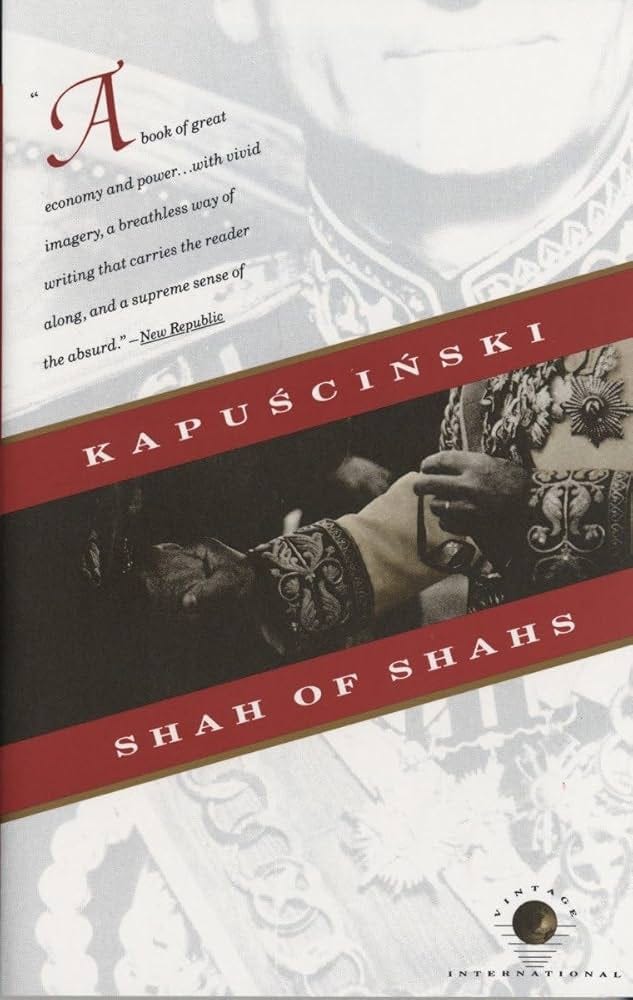Shah of Shahs, Ryzard Kapuscinski (1982)
Shah of Shahs, Ryzard Kapuscinski (1982). I got to thinking about Iranian history while reading Perlstein’s treatment of the 1979 revolution (and thinking back on Persepolis, which I used to teach in my Global History course at Loyola). I sent a long email to my friend Matt describing in (probably too much) detail what a great Netflix series could be made based on the story of the two Shahs of the 20th century, their regimes, the global politics involved, and the Revolution. He recommended this book, which is a short, impressionistic account of Reza Pahlavi, the moment in which his regime collapsed, and the social dynamics in Iran that led to the Revolution’s outcome.
Kapuscinski was a Polish journalist who came of age under Communism, traveled the world writing about revolutionary movements, especially in Africa, and eventually came home to chronicle the rise of Solidarity and collapse of Soviet hegemony in his native country. He has a beautiful narrative style, even in translation, and a keen eye for telling details. He’s also brilliant in describing a mood - especially, here, the mood of antipathy, resentment, and ultimately disgust on the part of all classes of Iranians, brought on by the excesses and insensitivities of the Shah’s rule.
Despite the title, this short book (just 152 pages) is not so much about Shah Reza Pahlavi as about the 1979 revolution that deposed and exiled him: why and how it happened, and why it assumed the particular theocratic character that it eventually did. It is a book about revolution from a journalist born in a Marxist regime who actually traveled the world seeking out and reporting on revolutions (and presumably reporting on them with more frankness and detail than he could have employed if writing about his native Poland at that time). Discussing the terror and repression inflicted by the Shah’s vicious SAVAK, the secret police, Kapuscinski observes that
All books about all revolutions begin with a chapter that describes the decay of tottering authority or the misery and sufferings of the people. They should begin with a psychological chapter, one that shows how a harassed, terrified man suddenly breaks his terror, stops being afraid. This unusual process … demands illumination. Man gets rid of fear and feels free. Without that there would be no revolution. (111)
In its focus on the “psychological” genesis of the ‘79 revolution, Shah of Shahs echoes my own strong interest in what I think of as “subjective” histories, or perhaps a plainer way to put it is, histories of “what it felt like” - which is necessarily a subjective thing, because different things feel different to different people. But there can also be shared feelings and commonalities, and in modern political societies, the interplay between those subjectivities and commonalities can tell, in a way, the whole story of an event or era. To give an example, Kapuscinski masterfully explains how the Shah’s “Great Civilization” - a series of top-down modernizing reforms, meant to bring Iran into the company of great Western nations in the span of a couple decades - felt to ordinary iranians not like progress, but as “a great shame and loss of face … above all a great humiliation.” (60) Then in a subsequent chapter, he explores the particular texture and dynamics of Shi’ite Islam during the Shah’s regime - a religion, of course, but also an attitude, that naturally cultivated and valorized the stance of “rabid oppositionist,” that tended to be colored by “[f]ervor, orthodoxy, and an obsessive, fanatic concern for doctrinal purity,” and whose clerics enjoyed at least a minimal degree of immunity from the persecutions of the regime and the Savak. All of which explains why fundamentalist Shi’ites like Khomeini (more than, say, Marxist-leftist elements) were ultimately able to power and sustain the successful overthrow of the Pahlavi regime.
The American understanding of the Iranian revolution was always preoccupied, understandably, with the so-called “hostage crisis” of the Carter years, which ended literally at the moment of Reagan’s inauguration in 1980. After that, Iran slid rapidly into a rigid theocratic regime, and just as rapidly out of most Americans’ attention. Although in recent years books like Persepolis and diplomacy surrounding John Kerry’s 2015 nuclear agreement have refocused a bit of attention on Iran, it remains little understood here, and I think, little cared about. I find that surprising and unfortunate, given that Persia is one of the world’s great civilizations with an incredibly fascinating history in both ancient and modern times, and Iran today is a key power in the Middle East and also a key instance of an antiliberal repressive regime of the type that seems to be on the rise across the globe. I want to learn a lot more about it, and this short book was an excellent place to start. (Read about the end of September 2024)




